2015 PEUGEOT 4008 tow bar
[x] Cancel search: tow barPage 126 of 389
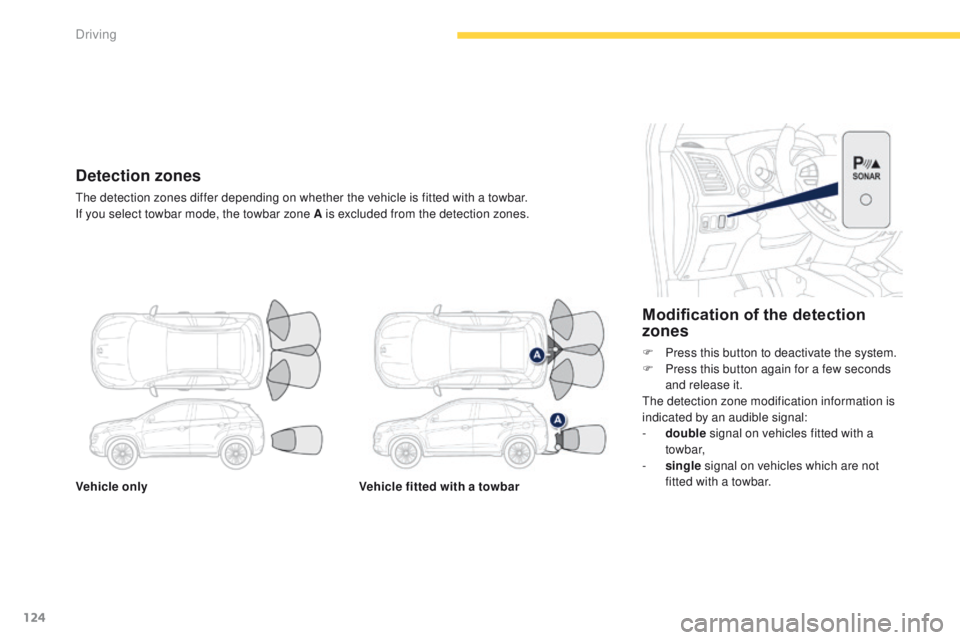
124
4008_en_Chap04_conduite_ed01-2014
Vehicle onlyVehicle fitted with a towbar
Modification of the detection
zones
F Press this button to deactivate the system.
F
P ress this button again for a few seconds
and release it.
th
e detection zone modification information is
indicated by an audible signal:
-
d
ouble signal on vehicles fitted with a
towbar,
-
si
ngle signal on vehicles which are not
fitted with a towbar.
Detection zones
the detection zones differ depending on whether the vehicle is fitted with a towbar.
If you select towbar mode, the towbar zone A is excluded from the detection zones.
Driving
Page 127 of 389
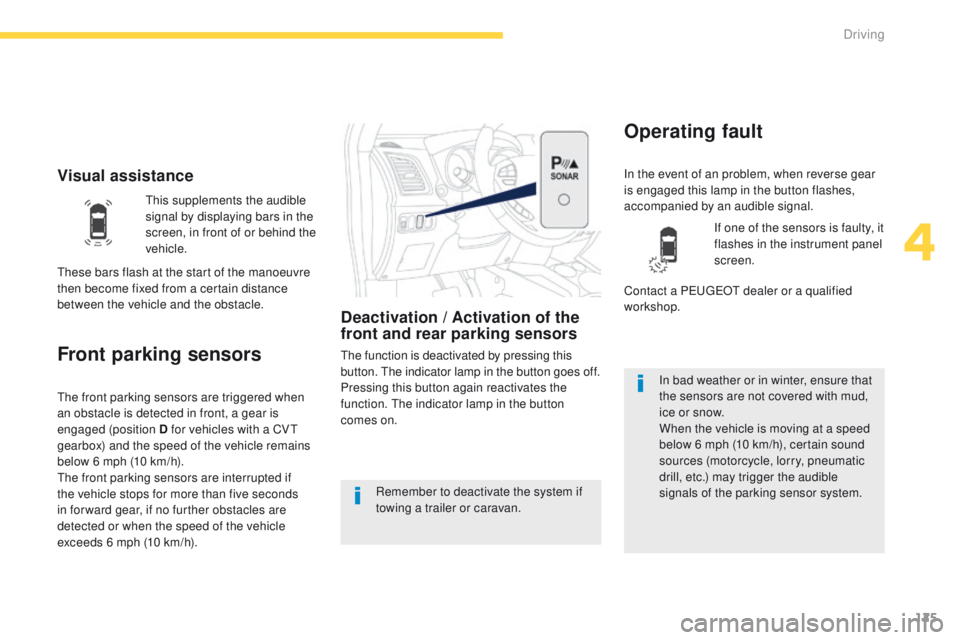
125
4008_en_Chap04_conduite_ed01-2014
Visual assistance
Front parking sensors
Deactivation / Activation of the
front and rear parking sensors
the function is deactivated by pressing this
button. th e indicator lamp in the button goes off.
Pressing this button again reactivates the
function.
t
h
e indicator lamp in the button
comes on.
Operating fault
the front parking sensors are triggered when
an obstacle is detected in front, a gear is
engaged (position D for vehicles with a CV
t
gearbox) and the speed of the vehicle remains
below 6 mph (10 km/h).
th
e front parking sensors are interrupted if
the vehicle stops for more than five seconds
in for ward gear, if no further obstacles are
detected or when the speed of the vehicle
exceeds 6 mph (10 km/h). Remember to deactivate the system if
towing a trailer or caravan.In bad weather or in winter, ensure that
the sensors are not covered with mud,
ice or snow.
When the vehicle is moving at a speed
below 6 mph (10 km/h), certain sound
sources (motorcycle, lorry, pneumatic
drill, etc.) may trigger the audible
signals of the parking sensor system.
In the event of an problem, when reverse gear
is engaged this lamp in the button flashes,
accompanied by an audible signal.
th
is supplements the audible
signal by displaying bars in the
screen, in front of or behind the
vehicle. If one of the sensors is faulty, it
flashes in the instrument panel
screen.
Contact a P
e
uge
Ot
dealer or a qualified
workshop.
th
ese bars flash at the start of the manoeuvre
then become fixed from a certain distance
between the vehicle and the obstacle.
4
Driving
Page 200 of 389
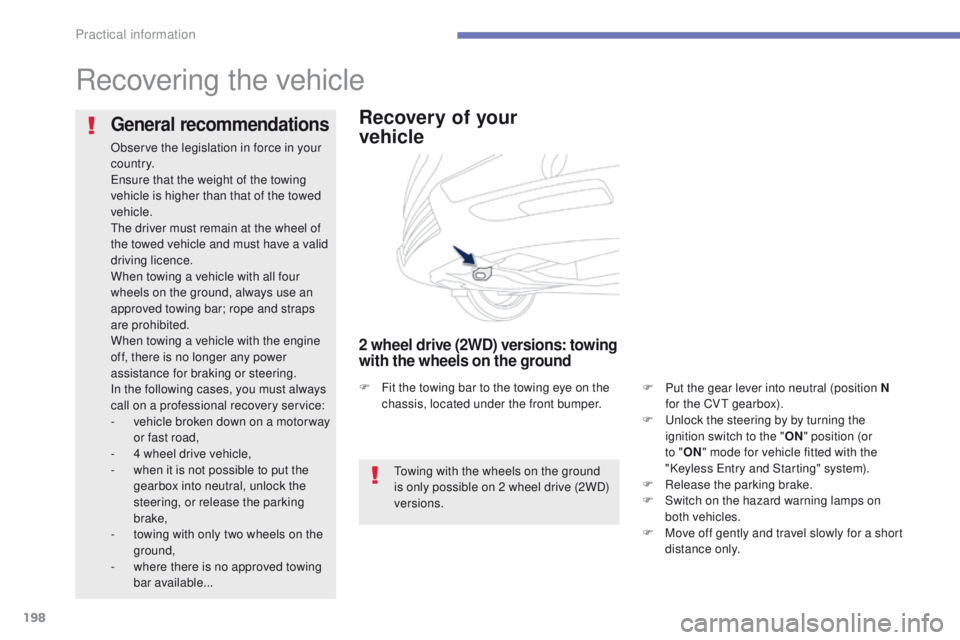
198
4008_en_Chap07_info-pratiques_ed01-2014
Recovering the vehicle
Recovery of your
vehicle
2 wheel drive (2WD) versions: towing
with the wheels on the ground
F Put the gear lever into neutral (position N for the CVt gearbox).
F
u
n
lock the steering by by turning the
ignition switch to the " ON" position (or
to " ON " mode for vehicle fitted with the
"Keyless
e
n
try and Starting" system).
F
R
elease the parking brake.
F
S
witch on the hazard warning lamps on
both vehicles.
F
M
ove off gently and travel slowly for a short
distance only.
General recommendations
Observe the legislation in force in your
c o unt r y.
en
sure that the weight of the towing
vehicle is higher than that of the towed
vehicle.
th
e driver must remain at the wheel of
the towed vehicle and must have a valid
driving licence.
When towing a vehicle with all four
wheels on the ground, always use an
approved towing bar; rope and straps
are prohibited.
When towing a vehicle with the engine
off, there is no longer any power
assistance for braking or steering.
In the following cases, you must always
call on a professional recovery service:
-
v
ehicle broken down on a motor way
or fast road,
-
4 w
heel drive vehicle,
-
w
hen it is not possible to put the
gearbox into neutral, unlock the
steering, or release the parking
brake,
-
t
owing with only two wheels on the
ground,
-
w
here there is no approved towing
bar available...
to
wing with the wheels on the ground
is only possible on 2 wheel drive (2WD)
versions.
F
F
it the towing bar to the towing eye on the
chassis, located under the front bumper.
Practical information
Page 202 of 389
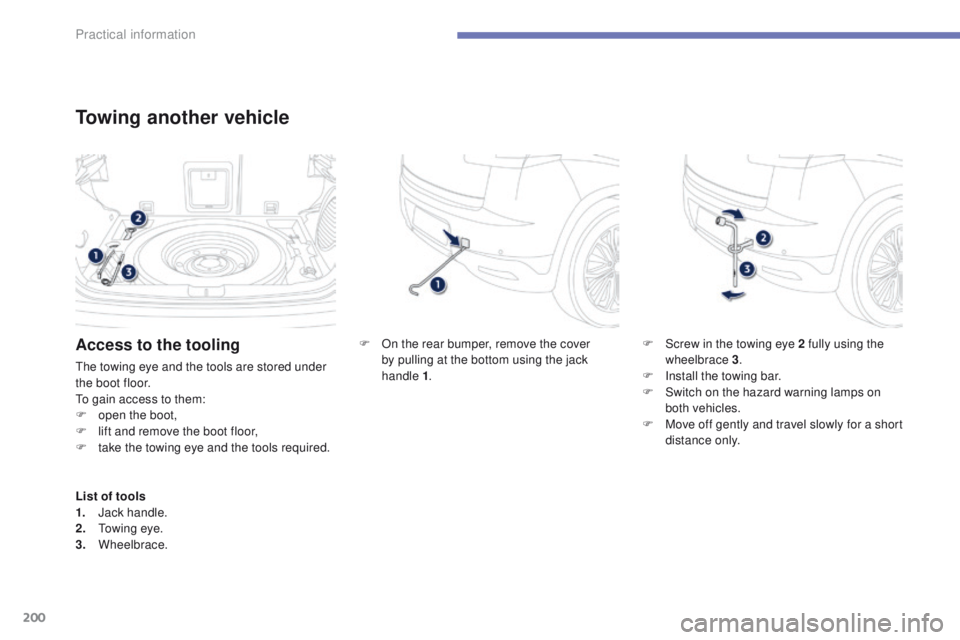
200
4008_en_Chap07_info-pratiques_ed01-2014
Towing another vehicle
F On the rear bumper, remove the cover by pulling at the bottom using the jack
handle
1. F
S crew in the towing eye 2 fully using the
wheelbrace 3 .
F
I
nstall the towing bar.
F
S
witch on the hazard warning lamps on
both vehicles.
F
M
ove off gently and travel slowly for a short
distance only.Access to the tooling
the towing eye and the tools are stored under
the boot floor.
to g
ain access to them:
F
o
pen the boot,
F
l
ift and remove the boot floor,
F
t
ake the towing eye and the tools required.
List of tools
1.
J
ack handle.
2.
t
o
wing eye.
3.
Wheelbrace.
Practical information
Page 203 of 389
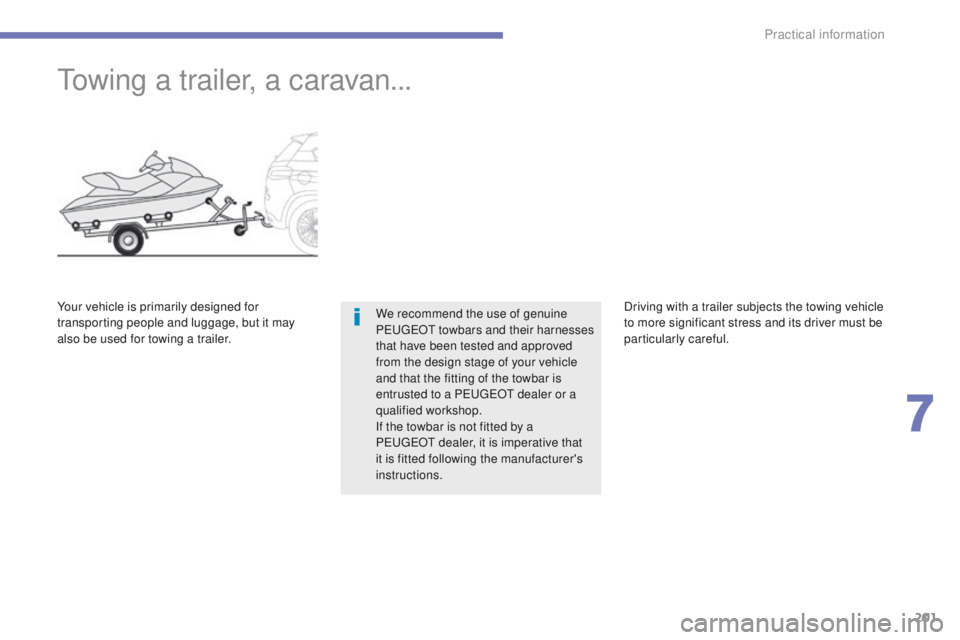
201
4008_en_Chap07_info-pratiques_ed01-2014
towing a trailer, a caravan...
We recommend the use of genuine
PeugeOt towbars and their harnesses
that have been tested and approved
from the design stage of your vehicle
and that the fitting of the towbar is
entrusted to a P
e
uge
Ot
dealer or a
qualified workshop.
If the towbar is not fitted by a
P
e
uge
Ot
dealer, it is imperative that
it is fitted following the manufacturer's
instructions.
Your vehicle is primarily designed for
transporting people and luggage, but it may
also be used for towing a trailer.
Driving with a trailer subjects the towing vehicle
to more significant stress and its driver must be
particularly careful.
7
Practical information
Page 205 of 389
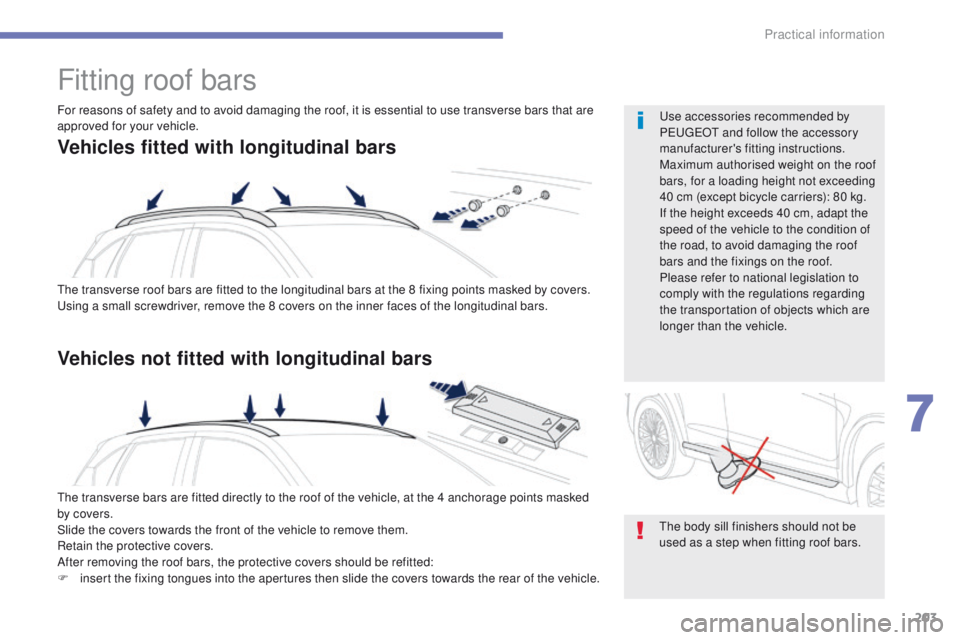
203
4008_en_Chap07_info-pratiques_ed01-2014
Fitting roof bars
the transverse roof bars are fitted to the longitudinal bars at the 8 fixing points masked by covers.using a small screwdriver, remove the 8 covers on the inner faces of the longitudinal bars.
th
e transverse bars are fitted directly to the roof of the vehicle, at the 4 anchorage points masked
by covers.
Slide the covers towards the front of the vehicle to remove them.
Retain the protective covers.
After removing the roof bars, the protective covers should be refitted:
F
i
nsert the fixing tongues into the apertures then slide the covers towards the rear of the vehicle.
th
e body sill finishers should not be
used as a step when fitting roof bars.
us
e accessories recommended by
P
e
uge
Ot
and follow the accessory
manufacturer's fitting instructions.
Maximum authorised weight on the roof
bars, for a loading height not exceeding
40 cm (except bicycle carriers): 80 kg.
If the height exceeds 40 cm, adapt the
speed of the vehicle to the condition of
the road, to avoid damaging the roof
bars and the fixings on the roof.
Please refer to national legislation to
comply with the regulations regarding
the transportation of objects which are
longer than the vehicle.
For reasons of safety and to avoid damaging the roof, it is essential to use transverse bars that are
approved for your vehicle.
Vehicles fitted with longitudinal bars
Vehicles not fitted with longitudinal bars
7
Practical information
Page 206 of 389
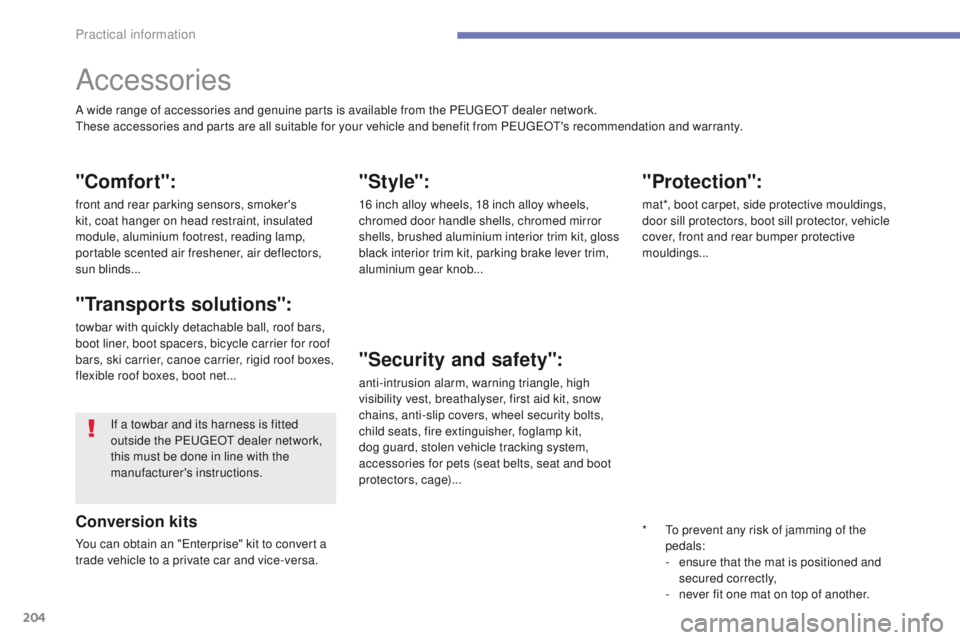
204
4008_en_Chap07_info-pratiques_ed01-2014
Accessories
A wide range of accessories and genuine parts is available from the PeugeOt dealer network.th
ese accessories and parts are all suitable for your vehicle and benefit from Pe ugeOt' s recommendation and warranty.
"Comfort":
front and rear parking sensors, smoker's
kit, coat hanger on head restraint, insulated
module, aluminium footrest, reading lamp,
portable scented air freshener, air deflectors,
sun blinds...
"Transports solutions":
towbar with quickly detachable ball, roof bars,
boot liner, boot spacers, bicycle carrier for roof
bars, ski carrier, canoe carrier, rigid roof boxes,
flexible roof boxes, boot net...
"St yle":
16 inch alloy wheels, 18 inch alloy wheels,
chromed door handle shells, chromed mirror
shells, brushed aluminium interior trim kit, gloss
black interior trim kit, parking brake lever trim,
aluminium gear knob...
"Security and safety":
anti-intrusion alarm, warning triangle, high
visibility vest, breathalyser, first aid kit, snow
chains, anti-slip covers, wheel security bolts,
child seats, fire extinguisher, foglamp kit,
dog guard, stolen vehicle tracking system,
accessories for pets (seat belts, seat and boot
protectors, cage)...
"Protection":
mat*, boot carpet, side protective mouldings,
door sill protectors, boot sill protector, vehicle
cover, front and rear bumper protective
mouldings...
Conversion kits
You can obtain an "enterprise" kit to convert a
trade vehicle to a private car and vice-versa. If a towbar and its harness is fitted
outside the P
e
uge
Ot
dealer network,
this must be done in line with the
manufacturer's instructions.
* to p revent any risk of jamming of the
pedals:
-
e
nsure that the mat is positioned and
secured correctly,
-
n
ever fit one mat on top of another.
Practical information
Page 340 of 389

338
4008_en_Chap11_index-alpha_ed01-2014
Seats, electric ................................................. 72
Seats, rear ....................................................... 75
Serial number, vehicle
......................................................... 235
Service indicator
............................................. 33
Servicing
...............................
..........................10
Setting the clock
................................ 44, 46, 48
Sidelamps
..................................... 182, 18 4, 18 6
Side repeater
..............................
..................185
Ski flap
..............................
..............................76
Snow chains
.................................................. 18
1
Spare wheel
...............................
...........114 , 17 6
Speedometer
.................................................. 12
Spotlamps, side
............................................ 185
Starting the vehicle
................................... 98, 99
Steering mounted controls, audio
............................ 251, 291, 314
Stopping the vehicle
.................................98, 99
Stop & Start system (Auto Stop
g
o
)
............................................ 111
St
orage
................................................ 76, 91, 96
Stowing rings
............................................ 96, 97
Sun visor
......................................................... 91
System, ABS
................................................. 142
System, audio-CD .................................. 311-333
System, audio-telematics
..................... 24
9 -288t CL ................................................................
14 4te
chnical data .......................................219 -232
te
lephone
............................................308, 309
te
lephone,with voice
recognition
...........................................2 37-24 8
te
mperature adjustment
...........................8
2, 84
te
mperature, coolant
......................................35
te
mporary puncture repair kit
......................171
th
ird brake lamp
...................................18 6, 187
thr
ee flashes function
(direction indicators)
...................................141
tM
C (
tr
affic info)
..........................................26
8
to
o l s
..............................................................175
to
tal distance recorder
...................................32
to
uch screen audio- CD system ...................289
tou
ch screen audio-telematic system
..........249
to
w b a r
...........................................................201
to
wed loads
...........................220-225, 227-232
to
wing another vehicle
.................................20
0
tP
(
tr
affic information)
.................2
74, 301, 320
tra
ction control (
tC
L)
...................................14
4
tr
affic information (
tM
C)
..............................26
8
tr
ajectory control systems ............................14 4
ty
re pressures
......................................114 , 2 3 5
ty
r e s
........................................................1 0 , 114
ty
re under-inflation detection
.................15 , 114
un
der-inflation (detection)
......................1
5 , 114
unl
ocking
..............................
....................52, 56
u
SB
..................94, 278 -281, 304-305, 328 -329
TU
Screen (audio equipment) .................44, 46, 48
Screen, instrument panel
....................................................... 19 - 31
Screen menu
........................................ 253, 294
Screenwash, front
......................................... 13 5
Screen-wash reservoir
.................................215
SD card
........................................ 265, 279, 280
Seat adjustment
...............................
.........71, 72
Seat back storage pockets
..............................
...........................95
Seat belts
............................................... 14
6 -149
Seat belts warning lamp
............................................................ 146
Repair kit, puncture
.......................................
171
Replacing bulbs
.....................................
182-187
Replacing fuses
..............................
.......
18 8 -19 3
Replacing the air filter
...................................
216
Replacing the oil filter
................................... 2
16
Replacing the passenger compartment filter
......................................
216
Replacing wiper blades .................................197
Rev counter
.....................................................
12
Reversing camera
.........................................
126
Reversing lamps
...................................
18 6, 187
Roof bars
....................................................... 20
3
Roof blind
........................................................
70
Routine checks
.....................................
216, 218
Running out of fuel (Diesel)
....................................................... 2
12
ta
ble of weights
.....................2
20-225, 227-232
tab
les of engines
..................................219, 226
ta
bles of fuses ..............................................188
S
Alphabetical index